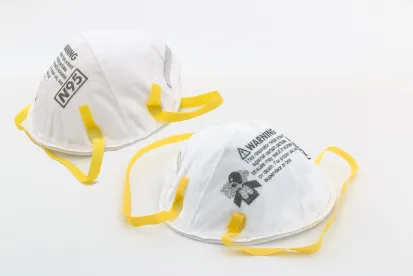On April 24, 2020, the Occupational Safety and Health Administration (OSHA) issued a memorandum titled “Enforcement Guidance on Decontamination of Filtering Facepiece Respirators in Healthcare During the Coronavirus Disease 2019 (COVID-19) Pandemic.” The guidance submits a list of approved and nonapproved decontamination methods for cleaning filtering facepiece respirators (FFRs), which are better known as N95 “dust mask” respirators. Due to the pandemic, N95 respirators—which are commonly used in healthcare settings—are currently experiencing overwhelming demand and supply shortages.
OSHA notes the compliance conundrum created by this situation. N95s were generally meant to be discarded after use. But with supplies short, “employers may find it necessary to decontaminate FFRs to facilitate their reuse.” OSHA already issued guidance permitting the continued use and reuse of respirators. The problem with N95 “dust mask” respirators, however, is that there are generally no methods approved by the National Institute for Occupational Safety and Health (NIOSH) to decontaminate them. Thus, “decontamination voids the NIOSH certification for the respirator.” Testing of decontamination methods is underway, but the process of obtaining NIOSH certification can be slow. OSHA issued this guidance relying on available research reviewed by NIOSH, to give inspectors and healthcare employers a heads-up on methods that show some effectiveness.
First, OSHA reminds employers to consider the hierarchy of controls to reduce the need for personal protective equipment (PPE). Employers should consider appropriate engineering and administrative controls, as well as safe work practices, before making the decision to resort to PPE. But the agency acknowledges that such controls can only go so far, and healthcare employers must still resort to PPE, including N95s, to adequately protect their frontline employees tending to COVID-19 patients. (If OSHA felt otherwise, there would be no need to issue so much guidance on N95s.)
OSHA asks healthcare employers to consider the following decontamination methods first:
-
“Vaporous hydrogen peroxide;
-
Ultraviolet germicidal irradiation; and/or
-
Moist heat (e.g., using water heated in an oven).”
If employers cannot use one of those three methods, the agency states healthcare employers may consider two other methods:
-
“Microwave-generated steam; and/or
-
Liquid hydrogen peroxide.”
Finally, OSHA insists that healthcare employers not use any of the following methods:
-
“Autoclaving;
-
Dry heat;
-
Isopropyl alcohol;
-
Soap;
-
Dry microwave irradiation;
-
Chlorine bleach; and/or
-
Disinfectant wipes, regardless of impregnation (i.e., chemical saturation); and/or
-
Ethylene oxide (EtO).”
The agency states that more research and “objective data” is needed on these methods. OSHA is particularly wary of ethylene oxide (EtO). While EtO shows some effectiveness at deactivating viral pathogens on FFRs, the substance is a known carcinogen.
Finally, OSHA reminds employers that “only respirator manufacturers can reliably provide guidance on how to decontaminate their specific models of FFRs. In the absence of manufacturers’ recommendations, third parties (e.g., respiratory protection or other industrial hygiene consultants) may also provide guidance or procedures on how to decontaminate respirators without impacting respirator performance.”
Takeaways
Of all the decontamination methods mentioned by OSHA, vaporous hydrogen peroxide may be the method gaining currency for N95s. Citing NIOSH’s review of available research, OSHA identified vaporous hydrogen peroxide as one of the methods offering “the most promise for decontaminating FFRs.” In addition, the U.S. Food and Drug Administration has issued Emergency Use Authorizations (EUAs) for systems using vaporous hydrogen peroxide. But for compliance purposes, it is reassuring for healthcare employers to have a list of OSHA-approved decontamination methods.
The guidance is limited to the healthcare industry. Other industries currently using N95s to protect employees from other hazards (e.g., from respirable crystalline silica in the construction industry) cannot rely upon this guidance. From a practical perspective, many non-healthcare employers may encounter feasibility issues in attempting to set up these systems. An ultraviolet germicidal irradiation system, for example, generally calls for repurposing a dedicated room at the location for the decontamination system, painting the walls with ultraviolet reflective paint, and stretching a series of “clotheslines” across the room, upon which hang N95s in a certain orientation before irradiation. Such a system may be cost-prohibitive or even impossible to develop at, say, a construction site.
From the agency’s perspective, virtually all of these methods are being developed with the healthcare industry in mind. This, along with the emphasis to preserve N95s for healthcare, indicates that OSHA may be hesitant to extend the guidance to non-healthcare industries. Still, for those employers with the resources and willpower to implement the approved systems, there is little harm in soliciting OSHA to extend the applicability of this guidance.




 />i
/>i

